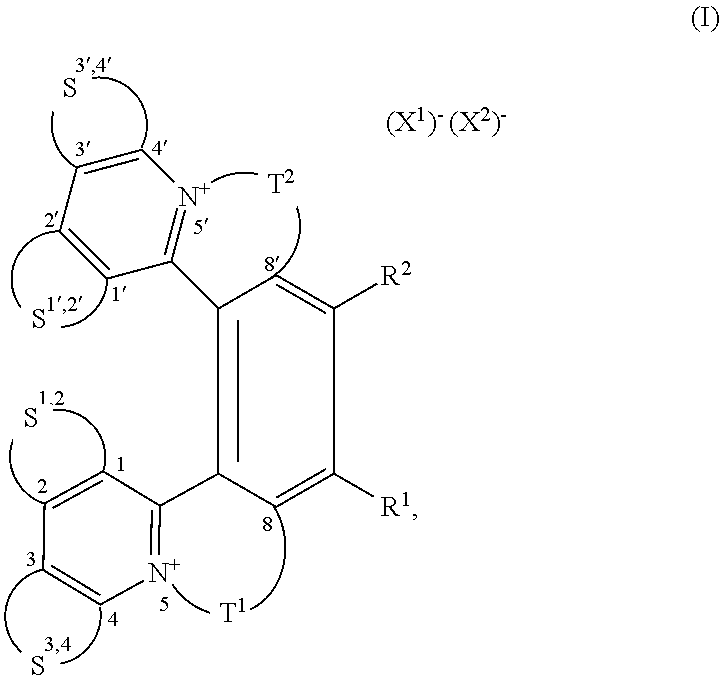Helquat derivatives, preparation thereof, and use thereof as medicaments
a technology of helquat and derivatives, applied in the field of helquat derivatives, preparation, can solve the problems of limited variability and perturbations in the normal functioning of proteins encoded by these genes, and achieve the effects of reducing the ability to induce resistance of the target cell, reducing toxicity, and increasing proliferation
- Summary
- Abstract
- Description
- Claims
- Application Information
AI Technical Summary
Benefits of technology
Problems solved by technology
Method used
Image
Examples
example 1
Preparation of (rac)-(E)-13-(4-(dimethylamino)styryl)-6,7-dimethyl-4,5,8,9-tetrahydroiso-quinolino[1,2-a]pyrido[1,2-k][2,9]phenanthroline-3,10-diium trifluoromethanesulfonate, i.e. (rac)-1
[0048]Starting racemic helquat A (144 mg, 0.213 mmol), 4-dimethylaminobenzaldehyde (41 mg, 0.275 mmol), pyrrolidine (0.20 ml, 2.44 mmol), and dry methanol (2.5 ml) were placed into a 10 ml flask and the resulting mixture was stirred under argon for 5 h at room temperature. Progress of the reaction was monitored by thin layer chromatography. Crude product was precipitated from the reaction mixture by addition of diethylether (90 ml). The suspension was centrifuged and the liquid was separated from the solid pellet. The solids were dissolved in methanol (5 ml) and the pure product was precipitated by addition of diethylether (40 ml). Then, centrifugation of this suspension, removal of the liquid, and drying of the solid product under vacuum of an oil pump led to 121 mg (0.150 mmol, 70% yield) of Knoe...
example 2
Preparation of (rac)-(E)-13-(2-(6-methoxynaphthalene-2-yl)vinyl)-6,7-dimethyl-4,5,8,9-tetrahydroisoquinolino[1,2-a]pyrido[1,2-k][2,9]phenanthroline-3,10-diium trifluoromethanesulfonate, i.e. (rac)-7
[0050]Starting racemic helquat A (58 mg, 0.085 mmol), 6-methoxy-2-naphtaldehyde (20 mg, 0.110 mmol), pyrrolidine (0.080 ml, 0.958 mmol), and dry methanol (1 ml) were placed into a flask and the mixture was stirred under argon for 20 h at room temperature. The reaction progress was monitored by thin layer chromatography. Crude product was isolated by a method analogous to that described in Example 1. This led to 45 mg (0.053 mmol, 62% yield) of Knoevenagel condensation product (r ac)-7 as an orange crystalline solid.
[0051]1H NMR (600 MHz, acetonitriled3): 2.44 (s, 3H, H-40), 2.45 (s, 3H, H-41), 3.05 (ddd, J=5.0; 14.2; 17.1 Hz, 1H, H-15a), 3.15 (bdt, J=4.6; 15.5; 15.5 Hz, 1H, H-8a), 3.50 (ddd, J=1.9; 3.5; 16.8 Hz, 1H, H-8b), 3.53 (ddd, J=1.8; 3.8; 17.1 Hz, 1H, H-15b), 3.93 (s, 3H, H-39), 4....
example 3
Preparation of 2-((1E,3E)-4-(1,2,3,5,6,7-hexahydropyrido[3,2,1-ij]quinolin-9-yl)buta-1,3-dien-1-yl)-6,7,10,11-tetrahydrodipyrido[2,1-a:1′,2-k][2,9]phenanthroline-5,12-diium trifluoromethanesulfonate
[0055]Starting helquat E (23 mg, 0.038 mmol), (E)-3-(1,2,3,5,6,7-hexahydropyrido[3,2,1-ij]quinoline-9-yl)acrylaldehyde (17 mg, 0.076 mmol), pyrrolidine (0.038 ml, 0.454 mmol), and dry methanol (4 ml) were placed into a flask and the mixture was stirred under argon for 1 h at room temperature. The reaction progress was monitored by thin layer chromatography. Crude product was isolated by a method analogous to that described in Example 1. This led to 23 mg (0.029 mmol, 76% yield) of Knoevenagel condensation product 31 as a dark blue solid.
[0056]1H NMR (400 MHz, acetonitriled3): 1.86-1.96 (m, 4H), 2.69 (t, J=6.3 Hz, 4H), 3.21-3.34 (m, 8H), 4.49-4.98 (m, 4H), 6.33 (d, J=15.2 Hz, 1H), 6.70-6.84 (m, 2H), 6.98 (s, 2H), 7.29 (dd, J=10.0, 15.2 Hz, 1H), 7.55 (d, J=1.9 Hz, 1H), 7.68-7.74 (m, 3H), 7....
PUM
| Property | Measurement | Unit |
|---|---|---|
| pharmaceutical stability | aaaaa | aaaaa |
| temperatures | aaaaa | aaaaa |
| humidities | aaaaa | aaaaa |
Abstract
Description
Claims
Application Information
 Login to View More
Login to View More - R&D
- Intellectual Property
- Life Sciences
- Materials
- Tech Scout
- Unparalleled Data Quality
- Higher Quality Content
- 60% Fewer Hallucinations
Browse by: Latest US Patents, China's latest patents, Technical Efficacy Thesaurus, Application Domain, Technology Topic, Popular Technical Reports.
© 2025 PatSnap. All rights reserved.Legal|Privacy policy|Modern Slavery Act Transparency Statement|Sitemap|About US| Contact US: help@patsnap.com



